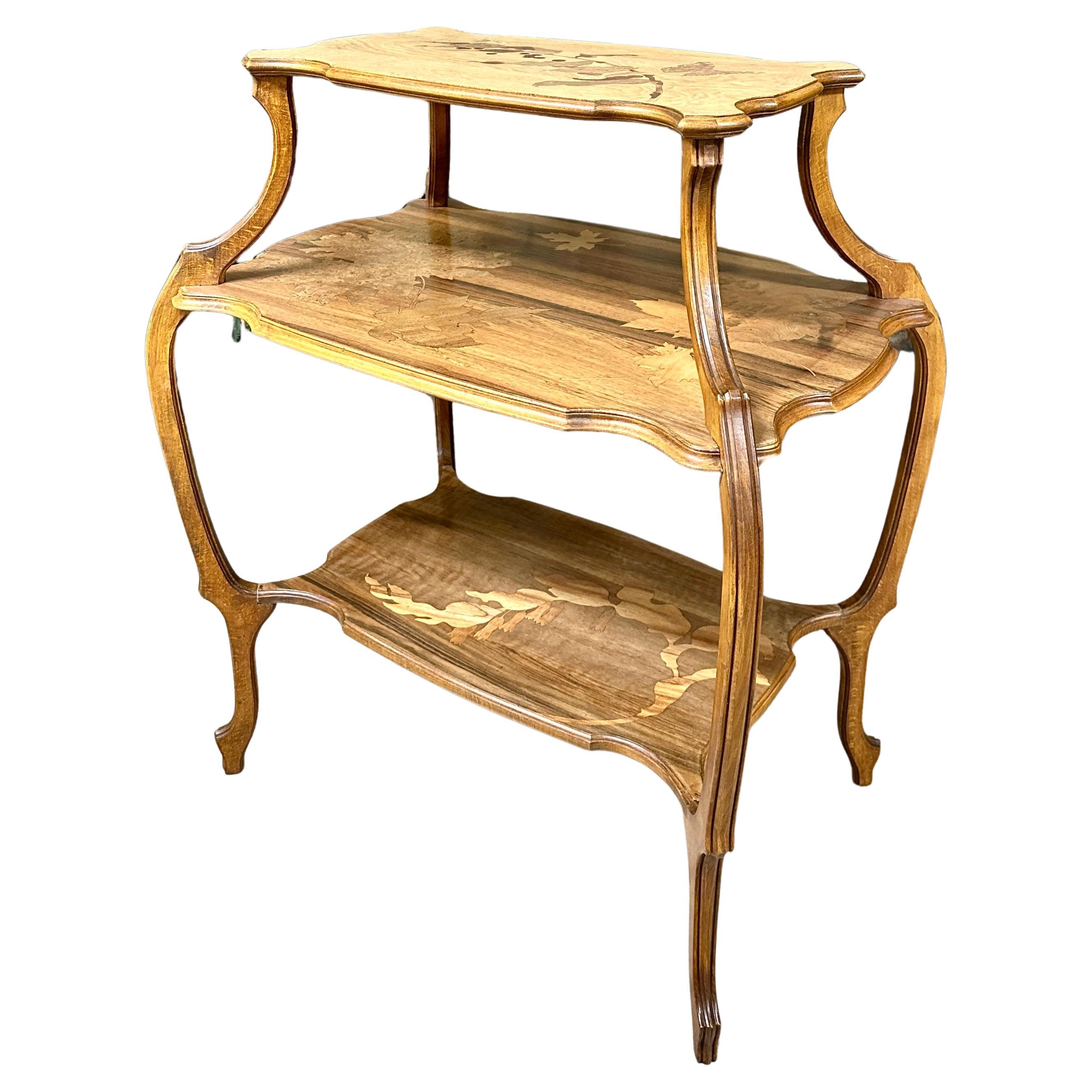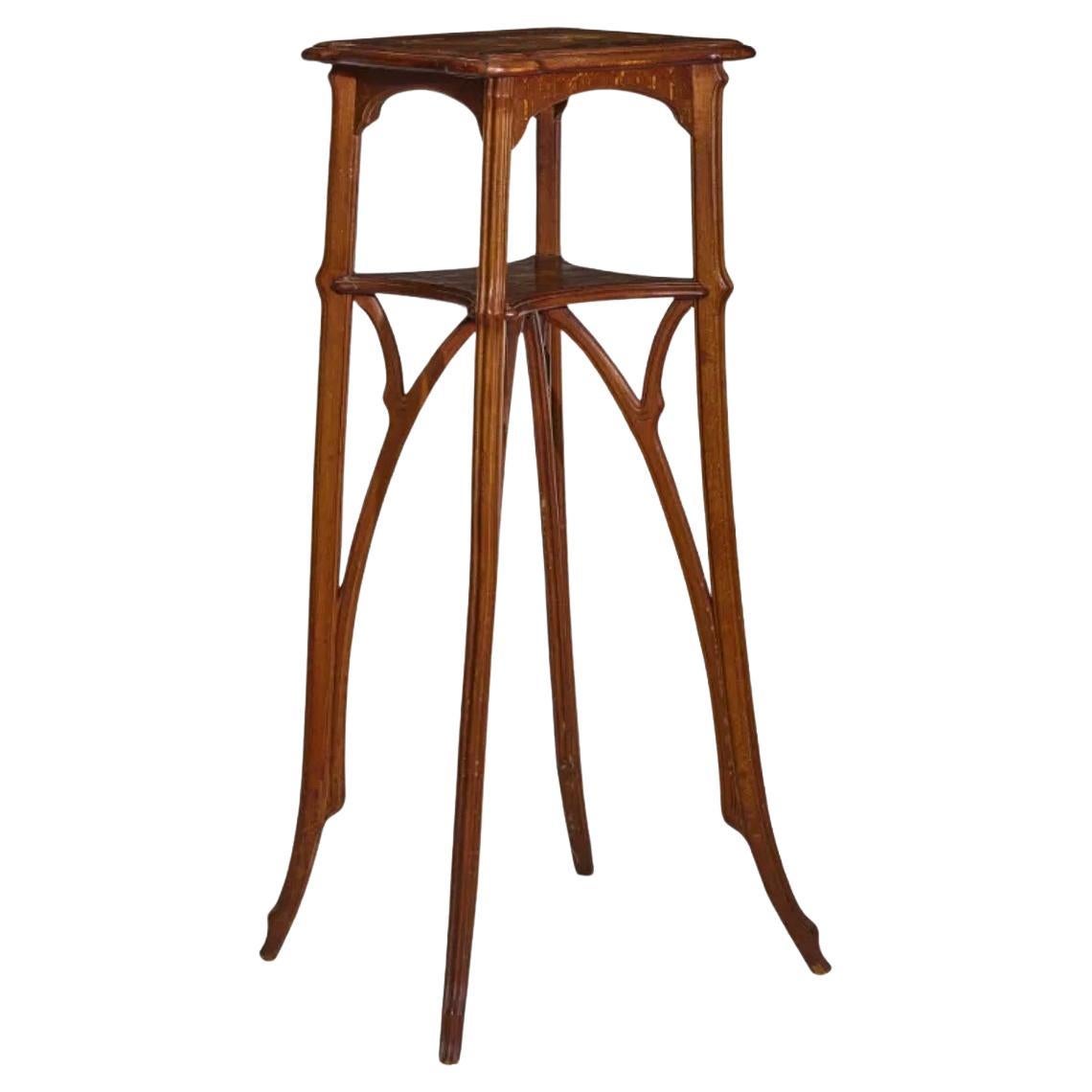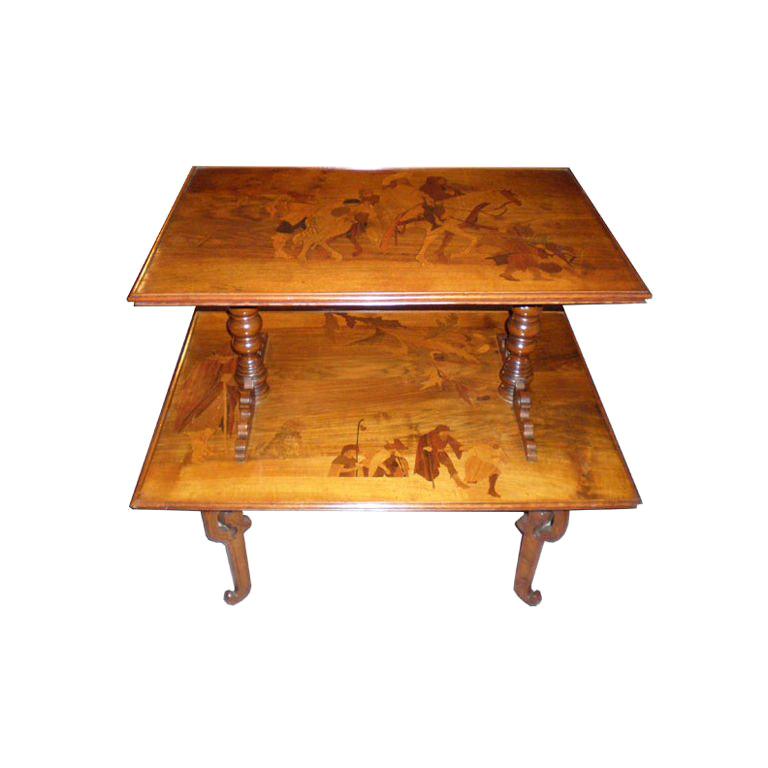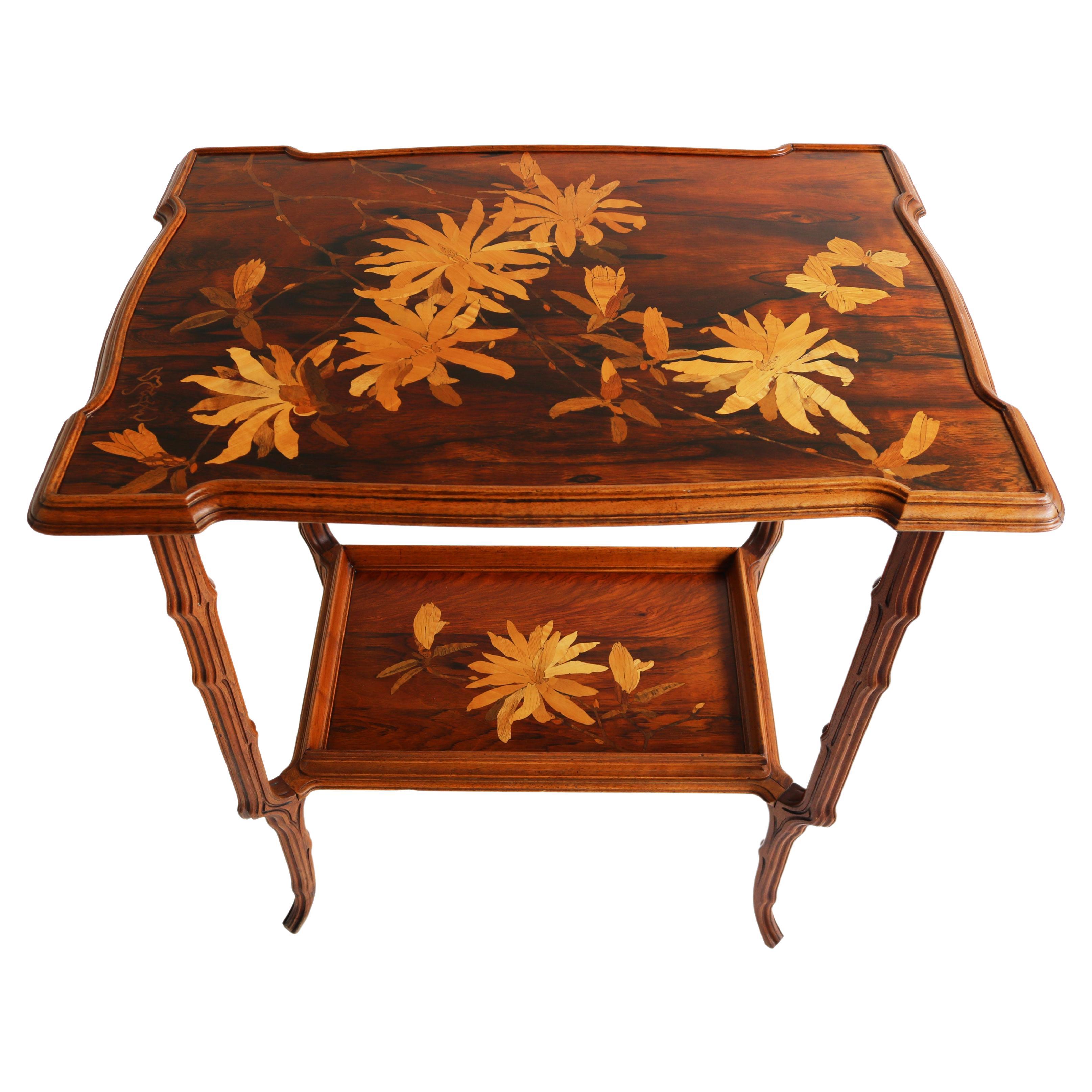Emile Galle Marquetry Three Tier Dragonfy and Botanical Table
About the Item
- Creator:Émile Gallé (Artist)
- Dimensions:Height: 34 in (86.36 cm)Width: 28 in (71.12 cm)Depth: 19 in (48.26 cm)
- Style:Art Nouveau (Of the Period)
- Materials and Techniques:
- Place of Origin:
- Period:1900-1909
- Date of Manufacture:1900
- Condition:Wear consistent with age and use. Some glue visible to some joints and evident care a cleaning but 99% original.
- Seller Location:Dallas, TX
- Reference Number:1stDibs: LU1774239788532
Émile Gallé
“Art for art’s sake” was a belief strongly espoused by the celebrated French designer and glassworker Émile Gallé. Through his ethereal glass vases, other vessels and lamps, which he adorned with botanical and religious motifs, Gallé advanced the Art Nouveau ideology and led the modern renaissance of French glass.
Gallé was the son of successful faience and furniture maker Charles Gallé but studied philosophy and botany before coming to glassmaking later in life. The young Gallé’s expertise in botany, however, would inform his design style and become his signature for generations to come.
After learning the art of glassmaking, Gallé went to work at his father’s factory in Nancy. He initially created clear glass objects but later began to experiment with layering deeply colored glass.
While glassmakers on Murano had applied layers of glass and color on decorative objects before Gallé had, he was ever-venturesome in his northeastern France, taking advantage of defects that materialized during his processes and etching in natural forms like insects such as dragonflies, marine life, the sun, vines, fruits and flowers modeled from local specimens.
Gallé is also credited with reviving cameo glass, a glassware style that originated in Rome. He used cabochons, which were applied raised-glass decorations colored with metallic oxides and made to resemble rich jeweling. Gallé's cameo glass vases and vessels were widely popular at the Paris Exhibition of 1878, cementing his position as a talented designer and pioneer.
During the late 19th century, Gallé led breakthroughs in mass production and employed hundreds of artisans in his workshop.
Botany and nature remained great sources of inspiration for the artist's glassmaking — just as they had for other Art Nouveau designers. From approximately 1890 to 1910, the movement’s talented designers produced furniture, glass and architecture in the form of — or adorned with — gently intertwining trees, flowers and vines. But Gallé had many interests, such as Eastern art and ceramics. The Japanese collection he visited at the Victoria and Albert Museum in London (then the South Kensington Museum) during the 1870s had made an impression too.
Breaking free from the rigid Victorian traditions, Gallé infused new life and spirit into the art and design of his time through exquisitely crafted glass vessels and pioneering new glassworking techniques.
Find a collection of Émile Gallé vases and other furniture and decorative objects on 1stDibs.
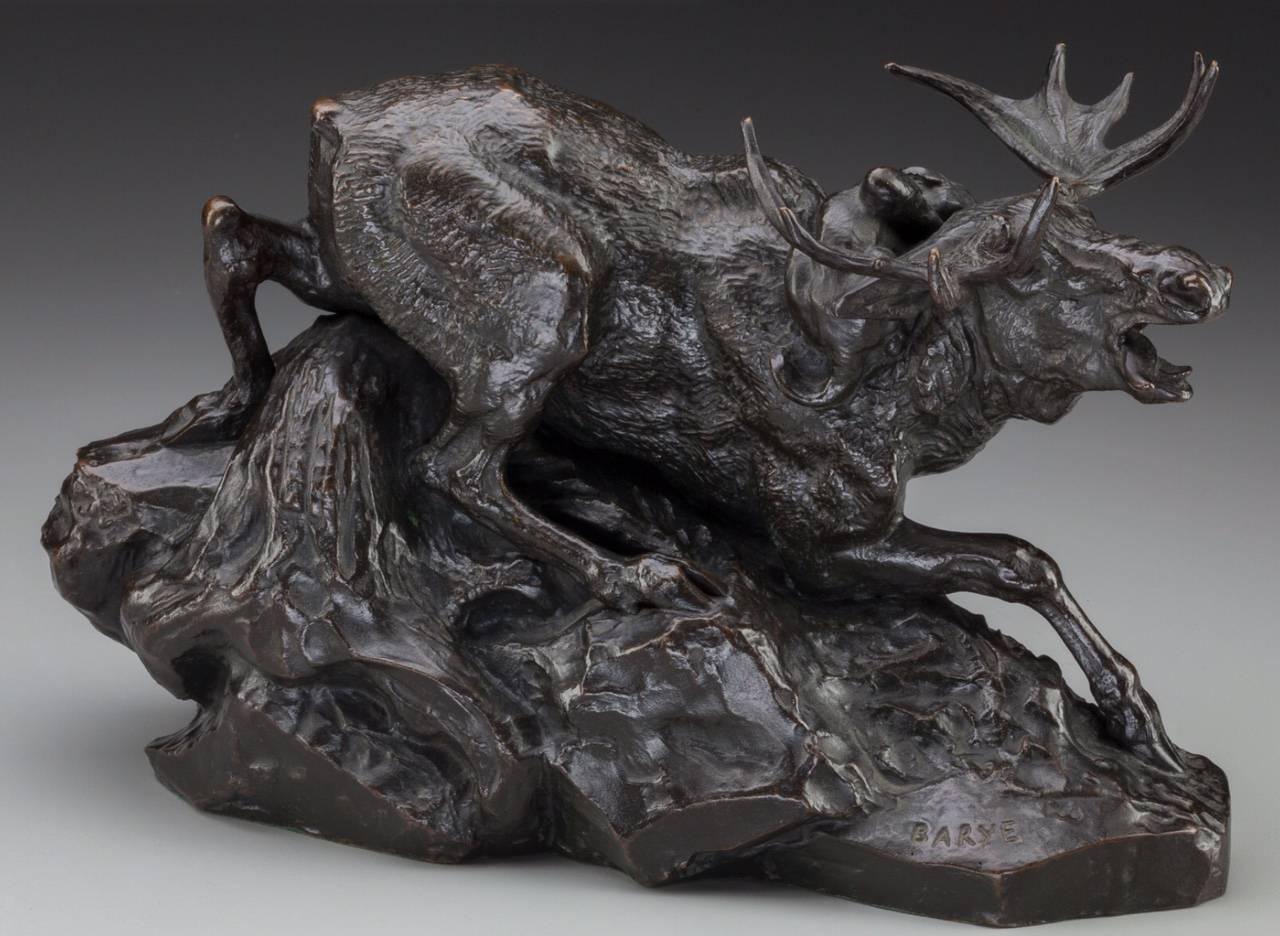
- ShippingRetrieving quote...Ships From: Dallas, TX
- Return PolicyA return for this item may be initiated within 7 days of delivery.
- Emile Galle Marquetry Two Tiered Walnut and Fruitwood TableBy Émile GalléLocated in Dallas, TXEmile Galle (1846-1904) Two-Tiered Table Circa 1900 Émile Gallé French Walnut and Fruitwood Marquetry Two-Tiered Pedestal table. This Art Nouveau classic two tiered French walnut p...Category
Antique Early 1900s French Art Nouveau Tables
MaterialsWalnut
- Monumental Emile Galle Four-Color Botanicals Vase, circa 1905By Émile GalléLocated in Dallas, TXA stunning four color wheel carved and acid etched fat vase with pink, yellow, greenish browns and white on a cream background. The coloring is strong and the workmanship excellent. ...Category
Antique Early 1900s French Art Nouveau Vases
MaterialsArt Glass
- Tall Emile Galle Lily Pedestaled VaseBy Émile GalléLocated in Dallas, TXAn important and exceptional tall cameo vase by Emile Galle. Circa 1900 in the Art Nouveau period. The technique is wheel carved, acid etched and carving to produce this over 20 Inch masterpiece of Tiger Lilies in their various open and closed stages. Galle was foremost a botanist and drew out and designed all his conceptions. What cant be seen in the photos is the cream shadows encompassing all the background flowers and stems. This vase is for serious collectors and those with impeccable taste. Signed: Galle in cameo Measures: Height: 20.2 Inches Diameter: 4.75 Inches Condition: Excellent AVANTIQUES is dedicated to providing an exclusive curated collection of Fine Arts, Paintings, Bronzes, Asian treasures, Art Glass and Antiques. Our inventory represents time-tested investment quality items with everlasting decorative beauty. We look forward to your business and appreciate any reasonable offers. All of our curated items are vetted and guaranteed authentic and as described. Avantiques only deals in original antiques and never reproductions. We stand behind our treasures with a full money back return policy if the items are not as described. Gallé born on 4 March 1846 in the city of Nancy, France. His father, Charles Gallé, was a merchant of glassware and ceramics who had settled in Nancy in 1844, and his father-in-law owned a factory in Nancy which manufactured mirrors. His father took over the direction of his mother's family business, and began to manufacture glassware with a floral design. He also took over a struggling faience factory and began make new products. The young Gallé studied philosophy and natural science at the Lycée Imperial in Nancy. At the age of sixteen he went to work for the family business as an assistant to his father, making floral designs and emblems for both faience and glass. In his spare time he became an accomplished botanist, studying with D.A. Godron, the director of the Botanical Gardens of Nancy and author of the leading textbooks on French flora. He collected plants from the region and from as far away as Italy and Switzerland. He also took courses in painting and drawing, and made numerous drawings of plants, flowers, animals and insects, which became subjects of decoration. At the age of sixteen he finished the Lycée in Nancy and went to Weimar in Germany from 1862-1866 to continue his studies in philosophy, botany, sculpture and drawing. In 1866, to prepare himself to inherit the family business, he went to work as an apprentice at the glass factory of Burgun and Schwerer in Meisenthal, and made a serious study of the chemistry of glass production. Some of his early glass and faience works for the family factory at Saint-Clémont were displayed at the 1867 Paris Universal Exposition. In early 1870 he designed a complete set of dishware with a rustic animal designs for the family enterprise. During this time he became acquainted with the painter, sculptor and engraver Victor Prouvé, an artist of the romantic "troubadour" style, who became his future collaborator in the Nancy School. He enlisted for military service in the Franco-Prussian War in 1870, then was demobilised after the disastrous French defeat in 1871 and the French loss to Germany of much of the province of Lorraine, including Meisenthal where he had done his apprenticeship. Thereafter the Cross of Lorraine, the patriotic symbol of the region, became part of his signature on many of his works of art. After his demobilization Gallé went to London, where he represented his father at an exhibition of the arts of France, then to Paris, where he remained for several months, visiting the Louvre and Cluny Museum, studying examples of ancient Egyptian art, Roman glassware and ceramics, and especially early Islamic enamelled...Category
Antique Early 1900s French Art Nouveau Vases
MaterialsArt Glass
- Large Emile Galle Scenic Cameo VaseBy Émile GalléLocated in Dallas, TXEmile Galle scenic wheel carved and acid etched cameo vase. A beautiful and tall cameo vase by Galle. The 18 - 1/2” tall vase has a background of muted yellow glass near the base, which progresses to blue/gray at mid-vase, and then peach towards the top. Brown, cameo cut trees are generously displayed across the body of the vase, with the addition of a boat in the lake. Signed "Galle". Dimensions: 18 - 1/2” x 10” x 8”. Condition: Very good Émile Gallé (8 May 1846 in Nancy – 23 September 1904 in Nancy) was a French artist and designer who worked in glass, and is considered to be one of the major innovators in the French Art Nouveau movement. He was noted for his designs of Art Nouveau glass art and Art Nouveau furniture, and was a founder of the École de Nancy or Nancy School, a movement of design in the city of Nancy, France. Gallé born on 4 March 1846 in the city of Nancy, France. His father, Charles Gallé, was a merchant of glassware and ceramics who had settled in Nancy in 1844, and his father-in-law owned a factory in Nancy which manufactured mirrors. His father took over the direction of his mother's family business, and began to manufacture glassware with a floral design. He also took over a struggling faience factory and began manufacturing new products. The young Gallé studied philosophy and natural science at the Lycée Imperial in Nancy. At the age of sixteen he went to work for the family business as an assistant to his father, making floral designs and emblems for both faience and glass. In his spare time he became an accomplished botanist, studying with D.A. Godron, the director of the Botanical Gardens of Nancy and author of the leading textbooks on French flora. He collected plants from the region and from as far away as Italy and Switzerland. He also took courses in painting and drawing, and made numerous drawings of plants, flowers, animals and insects, which became subjects of decoration. At the age of sixteen he finished the Lycée in Nancy and went to Weimar in Germany from 1862–1866 to continue his studies in philosophy, botany, sculpture and drawing. In 1866, to prepare himself to inherit the family business, he went to work as an apprentice at the glass factory of Burgun and Schwerer in Meisenthal, and made a serious study of the chemistry of glass production. Some of his early glass and faience works for the family factory at Saint-Clémont were displayed at the 1867 Paris Universal Exposition. In early 1870 he designed a complete set of dishware with a rustic animal designs for the family enterprise. During this time he became acquainted with the painter, sculptor and engraver Victor Prouvé, an artist of the romantic "troubadour" style, who became his future collaborator in the Nancy School. He enlisted for military service in the Franco-Prussian War in 1870, then was demobilised after the disastrous French defeat in 1871 and the French loss to Germany of much of the province of Lorraine, including Meisenthal where he had done his apprenticeship. Thereafter the Cross of Lorraine, the patriotic symbol of the region, became part of his signature on many of his works of art. After his demobilization Gallé went to London, where he represented his father at an exhibition of the arts of France, then to Paris, where he remained for several months, visiting the Louvre and Cluny Museum, studying examples of ancient Egyptian art, Roman glassware and ceramics, and especially early Islamic enamelled...Category
Antique Early 1900s French Art Nouveau Vases
MaterialsArt Glass
- Emile Galle Hydrangea Cameo Covered DishBy Émile GalléLocated in Dallas, TXGallé Cameo glass wheel carved and acid etched hydrangeas covered box, circa 1910. Art Nouveau. Marks: (star) Gallé (1904-1907) Height: 3 Inches, diameter 5.75 inches (7.4 x 14.6 cm) Condition: very good with no damage or repairs. Could use a good cleaning. This is dedicated to providing an exclusive curated collection of Fine Arts, Paintings, Bronzes, Asian treasures, Art Glass and Antiques. Our inventory represents time-tested investment quality items with everlasting decorative beauty. We look forward to your business and appreciate any reasonable offers. All of our curated items...Category
Antique Early 1900s Art Nouveau Vases
MaterialsArt Glass
- Emile Galle Leaves And Pods Art Nouveau Tall VaseBy Émile GalléLocated in Dallas, TXEmile Gallé Cameo Glass Leaves and Pods Vase, circa 1900 Marks: Gallé Height: 15.25 inches (38.7 cm) Width: 6.5 Inches Depth: 5 Inches Condition: Tall vase of colorless glass overlaid in peach, chartreuse and green acid-etched with cascading branches of maple leaves and seed pods. In overall very good condition. Émile Gallé (8 May 1846 in Nancy – 23 September 1904 in Nancy) was a French artist and designer who worked in glass, and is considered to be one of the major innovators in the French Art Nouveau movement. He was noted for his designs of Art Nouveau glass art and Art Nouveau furniture, and was a founder of the École de Nancy or Nancy School, a movement of design in the city of Nancy, France. Gallé born on 4 March 1846 in the city of Nancy, France. His father, Charles Gallé...Category
Antique Early 1900s French Art Nouveau Vases
MaterialsArt Glass
- Emile Gallé - Tea Table With Three Trays In Marquetry. Art Nouveau Period, 1900sBy Émile GalléLocated in NONANCOURT, FRTea table composed of a structure embellished with three trays richly inlaid with flowers, leaves and butterflies. Work signed "Gallé" on the upper plate with a vegetal signature as ...Category
Early 20th Century French Art Nouveau Coffee and Cocktail Tables
MaterialsFruitwood
- French Art Nouveau Marquetry Table by Emile GalléBy Émile GalléLocated in Kastrup, DKEmile Gallé, 1846-1904 A French Art Nouveau tray table crafted in walnut. Table top features exquisite floral marquetry woodwork in fruitwood and different wood species. With cabinet...Category
Antique Early 19th Century French Art Nouveau Tables
MaterialsFruitwood, Walnut
- Emile Galle "Ombelles" Floral and Pastoral Marquetry Writing DeskBy Émile GalléLocated in New York, NYFrench Art Nouveau writing desk featuring an open upper section with a marquetry inlaid pasteral scene back panel under a carved floral...Category
20th Century French Art Nouveau Desks and Writing Tables
MaterialsWood
- French Art Deco Emile Galle Two Tiered TableBy Émile GalléLocated in Pompano Beach, FLA two tiered French Art Deco Table in walnut with inlaid exotic woods. Signed Galle to upper right.Category
Early 20th Century French End Tables
MaterialsWalnut
- Original French Art Nouveau Marquetry Table ''Japonisme'' by Emile Galle 1900By Émile GalléLocated in Ijzendijke, NLVery rare original Emile Galle ''plate 66 Japonisme'' side table in Art Nouveau style. This beautiful side table was created by Emile Galle in 1900, during the art nouveau period. It features exquisite marquetry woodwork that is inspired by the Japonisme movement, which was influenced by Japanese art and design. The side table is decorated with breathtaking Magnolia flowers & a romantic couple of butterflies. Made from various types of wood, creating a unique scenery almost like a painting. The table showcases intricate details, such as delicate foliage and organic forms, that are hallmarks of art nouveau style. Galle was renowned for his innovative techniques and attention to detail, and this piece is a testament to his mastery of the craft. It is a stunning example of the art nouveau movement and a true work of art. Literature: ''Galle furniture by Alastair Duncan and Georges de Bartha 2012 Page 153. Plate 66. This Emile Galle table...Category
Antique Early 1900s French Art Nouveau Side Tables
MaterialsWalnut
- Emile Galle French Art Nouveau Floral Marquetry Rotating Top Occasional TableBy Émile GalléLocated in New York, NYFrench Art Nouveau occasional table with a circular top with shaped edge and floral marquetry inlay that rotates on a central axis, resting on four tapered sabre legs joined by a squ...Category
20th Century French Art Nouveau Side Tables
MaterialsWood
